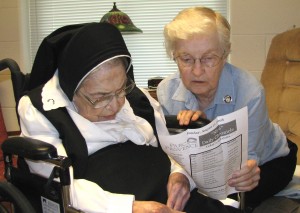“On the first day of school one year, I was telling the students about the schedule, and a boy raised his hand and asked, ‘When are you going to teach us to read?’” she said.
From 1955-59, she had her lone experience teaching in a public school, Holy Cross in Loretto, Ky. It wasn’t much different because all the students were Catholic, she said. She had to teach religion either after school or on Saturdays.
She left Kentucky for the first time from 1959-61, as one of three teachers at Good Shepherd School in Hillsboro, Mo., about 60 miles south of St. Louis. In 1961, she spent a year at St. Joseph School in Leitchfield, Ky., where she would teach a second-grader named John Meredith. Thirty-five years later, she would work with him again as Fr. John Meredith at Our Lady of Lourdes Parish in Owensboro, Ky.
Sister Mary Irene reads a letter to Sister Mary Bertha Wethington from her sister. Sister Mary Irene writes back to Sister Mary Bertha’s sister on her behalf.
From 1962-65, she returned to Earlington to teach kindergarten, a job she loved. “Kindergarten wasn’t a state requirement then, and I knew what first-graders needed to know, so I was free to teach what I wanted,” she said.
Her last stop as a teacher was at Seven Holy Founders School in Affton, Mo., a St. Louis suburb, where Ursulines had long had a presence. The school was so large she taught only half the first grade.
Administration
In 1969, she became a supervisor of teachers in the Archdiocese of Louisville. Her job was to visit schools to observe teachers and help with curriculum if needed. “They called us ‘snoopervisors’ because we watched people teach,” she said.
Learning the new job wasn’t Sister Mary Irene’s first challenge — it was learning to drive. The Ursuline rules at the time said sisters who lived together on a mission needed only one driver, so Sister Mary Irene had never learned. At age 42, she spent the summer before going to Louisville learning to drive on the county roads where she grew up.
She had her share of fender benders and embarrassing moments. One school she visited was on a one-way street that switched its direction of travel in the afternoon. She was only planning to be in the school for an hour one morning, but stayed much longer. When she came out, her car had been towed.
One summer, while working on her master’s degree in education at the University of Kentucky, the car wouldn’t start. She was in Lexington and needed to get back to Louisville, so a man showed her how to start a car by lifting the hood and using a nail in a well-placed spot. Thus, part of her education became how to hot-wire a car.
Leadership
While still in Louisville, she was elected to serve on the Leadership Council in late 1974, filling an unexpired term. She came back monthly for meetings for the next year, and then was elected to a four-year term on the council in 1976. In 1980, she began her first of two terms as major superior, a total of 13 years in leadership.
The biggest decision that happened during Sister Mary Irene’s term as superior was closing the Academy after 109 years, due to declining enrollment. “The decision wasn’t hard, it was telling the sisters,” Sister Mary Irene said. “We had the facts, we’d done a wide study. But announcing it to the sisters was very difficult. The sisters who were teaching there were committed to what they were doing.”
She believes having gone through such a change gives her and other sisters at the Mount some insight and additional empathy for the Ursuline Sisters of Paola, Kansas, who are closing their motherhouse and merging with Mount Saint Joseph.
Sister Mary Irene’s leadership photo.
Another change during her tenure was the council’s decision to move as one group to the Desenzano house on the northeast corner of the Motherhouse grounds, Sister Mary Irene said. “The sisters said, ‘We’ll never see you again.’” But after three months, they hadn’t noticed. “They said, ‘When are you going to move?’ We were still in our offices everyday.” (Today, only one of the five members of the Leadership Council lives at the motherhouse.)
An exciting time was the arrival of Bishop John McRaith in 1982. “He brought warmth, openness, and a gratitude for what the Ursulines had done for the diocese,” Sister Mary Irene said.
It was the Diocese of Owensboro’s first bishop, Francis Cotton, who said every parish must have a school. In a diocese with mostly rural communities, it was the Ursuline Sisters who traveled to the rural areas of the state to establish those schools. “You see that at our picnic, so many people come from rural parishes,” Sister Mary Irene said.
During her first term as superior, her assistant on the council was Sister Marie Goretti Browning. She was impressed by “how deeply (Sister Mary Irene) cared for the sisters, her deep trust in God and that she was always trying to find out what God’s will was for us,” Sister Marie Goretti said. “She’s very spiritual and prayerful.”
Sister Mary Irene is very intelligent and perceptive, Sister Marie Goretti said. “She was able to sense what needed to be done,” Sister Marie Goretti said. “I admire her very much.”
Sister Marietta Wethington joined the Leadership Council for Sister Mary Irene’s second term as superior. “The thing that impressed me the most was her deep spirituality,” Sister Marietta said. “She’s compassionate, gentle and caring. She trusted us and our instincts on leadership. Even though she’s quiet, she’s dynamic. A friend of mine who worked with her at the Catholic Pastoral Center called her a ‘quiet fire.’”

